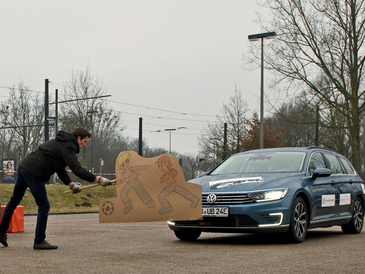Self-driving cars with no steering wheels or pedals, local transport vehicles or fleets of driverless trucks, relaxed travel, leaving the driving entirely up to the vehicle: These are the scenarios associated with autonomous driving. “And they are moving ever closer to becoming reality,” says Professor Christof Büskens, leader of the project 'AO-Car' – the abbreviation stands for “Autonomous Optimal”. “Over the past few months, we have taken important steps towards autonomous driving and gained many fundamental research findings designed to make autonomous driving reliable and safe.”
Technology makes the decisions
Demonstrations on the university parking lot showed how a vehicle independently explores a parking space. Based on sensor information, control signals (throttle, brake, steering wheel) are calculated to steer the vehicle for the next few seconds or minutes. “Independent of driver input, the technology makes autonomous decisions about the optimal driving maneuvers that are necessary in the respective situation and executes them in a regulated manner,” says Dr.-Ing. Mitja Echim from the Center for Industrial Mathematics (ZeTeM). The vehicle orients itself independently in the parking lot, moves in and out of a parking space, avoids obstacles, and makes emergency stops.
Since September 2016, the University of Bremen and the University of the German Federal Armed Forces in Munich have been researching methods for the highly automated navigation and control of automobiles. The cooperation is based on innovative algorithms developed in aerospace research. And since May 2017, a research team from the University of Bremen equipped with a special permit has been on the roads in Bremen and Lower Saxony with a specially equipped series-produced automobile to analyze highly automated driving maneuvers in real traffic situations – intersections, country roads, highways, parking lots and much more. At the same time, mathematicians and computer scientists are working on algorithms and evaluating the test results in order to constantly improve automated driving.
Optimum control and regulation
“The challenge is to combine multisensory information, experience values and real-time information to determine current vehicle and location conditions,” explains Joachim Clemens from the Cognitive Neuroinformatics Group. “At the same time, the surrounding environment must be reproduced. The appropriate maneuvers for the situation at hand must then be calculated to ensure optimum control and regulation.”At the same time, risk assessments are necessary that take into account the ever-present 'uncertain knowledge' – which can in turn lead to behavioral changes and the generation of new maneuvers.
“Autonomous driving is the subject of intensive research worldwide,” says Professor Büskens. “In contrast to existing approaches, the driving behavior we have developed is characterized by the fact that it uses new methods for risk calculation, mapping, and dealing with uncertain information.” With a fundamentally different approach to the determination of optimal driving maneuvers, the 'Bremer driving model' can guarantee stability and expandability with regard to a diversity of possible driving situations.
Next step: From the parking lot onto the road
In the next step, the Bremen researchers want to concentrate on moving tests from the parking lot onto the road. The focus is on interurban and city traffic. “The consistent further development of the algorithms aims above all at ensuring safety,” says Christof Büskens. Together with the project’s industrial partners, the existing algorithms are evaluated in order to be able to apply the research results over the longer term.
The 'AO-Car' project is jointly funded by the German Aerospace Center and the Federal Ministry for Economic Affairs and Energy. More information under: www.math.uni-bremen.de/zetem/aocar
Members of the press please note:
Images of the live demonstration of the research vehicle on the university parking lot can be downloaded here: https://seafile.zfn.uni-bremen.de/f/56019892a2df4d5da579/ .
If you would like to have more information on this topic, feel free to contact:
Dr-Ing. Mitja Echim
University of Bremen
Center for Industrial Mathematics (ZeTeM)
Phone: 0421/218-63865
Email: mitjaprotect me ?!math.uni-bremenprotect me ?!.de

